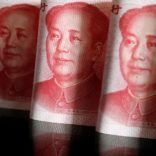G7 glosses over tariffs, pledges to cut global economic imbalances
Euro hits two-week high as ECB pushes back on imminent rate cuts

File photo: Reuters
The euro hit a two-week high against the U.S. dollar on Thursday as the European Central Bank pushed back against imminent interest rate cuts, a day after the Federal Reserve indicated that it is done hiking rates and is likely to cut them in 2024.
The greenback tumbled broadly, meanwhile, for a second day and reached a 4-1/2 month low against the Japanese yen.
The ECB held rates steady, as was widely expected, but “was unable to “out-dove” yesterday’s pivot by the Fed,” said Samuel Zief, head of global FX strategy at JPMorgan Private Bank in London.
“The ECB continues to signal that rate hikes are done but their updated economic projections show no reason to hurry towards less restrictive policy,” Zief said.
Fed Chair Jerome Powell said at Wednesday’s Federal Open Market Committee (FOMC) meeting that the tightening of monetary policy is likely over, with a discussion of cuts in borrowing costs coming “into view”. The Fed’s projections implied 75 basis points of cuts next year, from the current level.
“The Fed was very dovish yesterday,” said Athanasios Vamvakidis, global head G10 FX strategy at BofA Global Research. “The strong consensus… was for a balanced tone by Powell. Instead, Powell doubled-down, with a very dovish tone.”
The dollar index was last at 101.96, down 0.88% on the day and the lowest since August 10. The euro gained 1.03% to $1.0987, the highest since Nov. 29.
Fed funds futures traders are now almost completely pricing in a 25 basis points cut in March, and 150 basis points in rate reductions by Dec. 2024.
“The market has been coming around to the idea that inflation won’t be sticky or problematic over the past six weeks and now central banks are confirming it,” said Adam Button, chief currency analyst at ForexLive in Toronto.
“The market is running with the idea that rates will return to low levels in time – the bigger picture idea is that we’re headed back to a 2010s era of low growth and low inflation, rather than a 1970s era of volatile inflation,” he said.
The greenback briefly pared losses after data showed that U.S. retail sales unexpectedly rose in November as the holiday shopping season got off to a brisk start, which should keep the economy on a moderate growth path this quarter.
The greenback fell 0.48% against the Swiss franc to the lowest since July 27 after the Swiss National Bank held rates steady at 1.75%, as expected and acknowledged that inflationary pressure has decreased slightly over the past quarter.
It also tumbled 2.54% against the Norwegian crown to the lowest since August 15 after the Norges Bank unexpectedly raised rates by 25 basis points to 4.5%, adding that they would likely stay at that level for some time.
The pound rose 1.03% and was the highest since Aug. 23 after the Bank of England left interest rates unchanged and said that interest rates needed to stay high for “an extended period”.
“The main message remains that rates will remain high for as long as it takes, which effectively is a push-back to market pricing early cuts,” said BofA’s Vamvakidis.
The yen reached the highest since July 31, with the dollar last down 0.82% against the Japanese currency at 141.73.
Expectations that the Bank of Japan (BOJ) could end negative interest rates at its monetary policy meeting on Dec. 18-19 have largely been dampened, but the BOJ could make tweaks to its statement, such as language that the bank will not hesitate to ease further if necessary, said Masafumi Yamamoto, chief currency strategist at Mizuho Securities.
That kind of change could be regarded as “one step toward normalisation … so that could be positive for the Japanese yen”, he said.












Leave a Reply
Be the First to Comment!
You must be logged in to post a comment.
You must be logged in to post a comment.